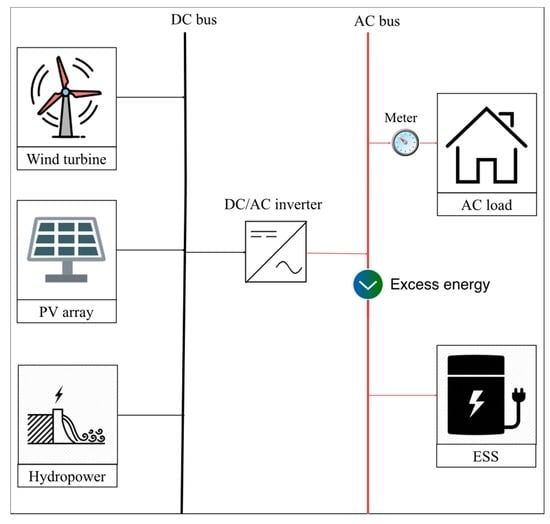100% Renewable Energy Grid for Rural Electrification of Remote Areas: A Case Study in Jordan
Abstract
:1. Introduction
2. System Description and Methodology
2.1. RES Description
2.1.1. Solar Energy System
2.1.2. Wind Energy System
2.1.3. Hydropower System
2.2. System Modelling and Energy Flow: With and Without an Energy Storage System
2.3. Optimization Procedure
2.4. Economic Assessment and System’s Feasibility
3. Results and Discussion
4. Conclusions
Author Contributions
Funding
Acknowledgments
Conflicts of Interest
Nomenclature
| Annual energy production from the hydropower system, kWh | Average wind speed at ground level, m/s | ||
| Hourly energy generated from the PV power plant, kWh | Rated wind speed, m/s | ||
| generated by a wind turbine(s), kWh | Wind speed at hub height, m/s | ||
| Energy stored at time t, kWh | Mean wind speed at hub height, m/s | ||
| Battery capacity, kWh | Hub height, m | ||
| RES Fraction, % | Height of the ground level, m | ||
| Reference insolation at nominal conditions, Wh/m2 | Acronyms and Abbreviations | ||
| Global insolation on a tilted surface, Wh/m2 | ESS | Energy storage system | |
| Shape parameter of the Weibull distribution | GHGs | Greenhouse gases | |
| Lifetime of the system, years | GRG | Generalized reduced gradient | |
| Levelized Cost of Electricity, USD/kWh | LCOE | Levelized cost of electricity | |
| Yearly fixed maintenance cost of the RES, USD | NPV | Net present value | |
| Number of modules in the PV power plant | PBP | Payback period | |
| Nominal operating cell temperature, oC | PV | Photovoltaic | |
| Hydropower capacity, kW | RES | Renewable energy system | |
| Rated electrical power of the wind turbine, kW | ZBB | Zinc-Bromine battery | |
| Annual discount rate, % | Greek letters | ||
| Ambient temperature, oC | Wind shear coefficient | ||
| Reference module temperature at nominal conditions, oC | Temperature coefficient, 1/°C | ||
| Reference module temperature at standard conditions, oC | System losses, % | ||
| Cut-in wind speed of the wind turbine, m/s | Reference efficiency of the PV module, % | ||
| Cut-out wind speed, m/s | PV module efficiency | ||
| Standard deviation of the wind speeds sample, m/s | |||
Appendix A.
| Quantity | Equation | Key Points | Equation Number |
|---|---|---|---|
| PV Energy model | |||
| The PV module efficiency | Neglecting the effects of relative humidity and wind speeds, while considering the effect of the ambient temperature [56,57]. | (A1) | |
| The hourly energy generated from the PV power plant | was taken 0.85 based on [58,59] | (A2) | |
| Wind Energy model | |||
| The wind speed at hub height | α can be taken as 1/7 [39], Zg is the height of the ground level [m] at which speed is measured and it is equal 10 m. | (A3) | |
| total hourly electrical energy generated by a wind turbine(s) | By [39] | (A4) | |
| Shape Parameter | (A5) | ||
| Hydropower Model | |||
| Annual energy production from the hydropower system | () of 80% [41] | (A6) | |
| Performance assessment of RES | |||
| RES Fraction | is the hourly demand of Al-Tafilah [kWh] which was obtained from [44] | (A7) | |
| Economic Assessment of the RES | |||
| The Levelized Cost of electricity | (A8) | ||
References
- Jaber, J.; Badran, O.O.; Abu-Shikhah, N. Sustainable energy and environmental impact: Role of renewables as clean and secure source of energy for the 21st century in Jordan. Clean Technol. Environ. Policy 2004, 6, 174–186. [Google Scholar] [CrossRef]
- Hrayshat, E.S. Analysis of renewable energy situation in Jordan. Renew. Sustain. Energy Rev. 2007, 11, 1873–1887. [Google Scholar] [CrossRef]
- Ahmad, A.D.; Abubaker, A.M.; Najjar, Y.S.; Manaserh, Y.M.A. Power boosting of a combined cycle power plant in Jordan: An integration of hybrid inlet cooling & solar systems. Energy Convers. Manag. 2020, 214, 112894. [Google Scholar] [CrossRef]
- Bortolini, M.; Gamberi, M.; Graziani, A. Technical and economic design of photovoltaic and battery energy storage system. Energy Convers. Manag. 2014, 86, 81–92. [Google Scholar] [CrossRef]
- Al-Ghussain, L. Global warming: Review on driving forces and mitigation. Environ. Prog. Sustain. Energy 2019, 38, 13–21. [Google Scholar] [CrossRef] [Green Version]
- Timmerberg, S.; Sanna, A.; Kaltschmitt, M.; Finkbeiner, M. Renewable electricity targets in selected MENA countries—Assessment of available resources, generation costs and GHG emissions. Energy Rep. 2019, 5, 1470–1487. [Google Scholar] [CrossRef]
- Abubaker, A.M.; Magableh, M.N.A.; Darwish-Ahmad, A.; Najjar, Y.S.H. Efficiency boosting and steam saving for a steam-injected gas turbine engine: An optimization study of the running conditions. J. Energy Eng. [CrossRef]
- Ahmad, A.D.; Abubaker, A.M.; Salaimeh, A.A.; Akafuah, N.K. Schlieren visualization of shaping air during operation of an electrostatic rotary bell sprayer: Impact of shaping air on droplet atomization and transport. Coatings 2018, 8, 279. [Google Scholar] [CrossRef] [Green Version]
- Ahmad, A.D.; Singh, B.B.; Doerre, M.; Abubaker, A.M.; Arabghahestani, M.; Salaimeh, A.A.; Akafuah, N.K. Spatial positioning and operating parameters of a rotary bell sprayer: 3D mapping of droplet size distributions. Fluids 2019, 4, 165. [Google Scholar] [CrossRef] [Green Version]
- Sharadga, H.; Dawahdeh, A.; Al-Nimr, M.A. A hybrid PV/T and Kalina cycle for power generation. Int. J. Energy Res. 2018, 42, 4817–4829. [Google Scholar] [CrossRef]
- Harris, C.B.; Meyers, J.P.; Webber, M.E. A unit commitment study of the application of energy storage toward the integration of renewable generation. J. Renew. Sustain. Energy 2012, 4, 013120. [Google Scholar] [CrossRef] [Green Version]
- Al-Ghussain, L.; Samu, R.; Taylan, O.; Fahrioglu, M. Sizing renewable energy systems with energy storage systems in microgrids for maximum cost-efficient utilization of renewable energy resources. Sustain. Cities Soc. 2020, 55, 102059. [Google Scholar] [CrossRef]
- Najjar, Y.S.; Abubaker, A.M. Thermoeconomic analysis and optimization of a novel inlet air cooling system with gas turbine engines using cascaded waste-heat recovery. Energy 2017, 128, 421–434. [Google Scholar] [CrossRef]
- Al-Ghussain, L.; Taylan, O.; Fahrioglu, M. Sizing of a photovoltaic-wind-oil shale hybrid system: Case analysis in Jordan. J. Sol. Energy Eng. 2018, 140, 011002. [Google Scholar] [CrossRef]
- Anagreh, Y.N.; Bataineh, A.S. Renewable energy potential assessment in Jordan. Renew. Sustain. Energy Rev. 2011, 15, 2232–2239. [Google Scholar] [CrossRef]
- Cromartie, J. What is Rural? Available online: https://www.ers.usda.gov/topics/rural-economy-population/rural-classifications/what-is-rural/#:~:text=According%20to%20this%20system%2C%20rural,with%20fewer%20than%202%2C500%20people (accessed on 17 September 2020).
- Azad, H.B.; Mekhilef, S.; Saidur, R.; Boroumandjazi, G. Potential application of renewable energy for rural electrification in Malaysia. Renew. Energy 2013, 59, 210–219. [Google Scholar] [CrossRef]
- Alazraque-Cherni, J. Renewable energy for rural sustainability in developing countries. Bull. Sci. Technol. Soc. 2008, 28, 105–114. [Google Scholar] [CrossRef] [Green Version]
- Anderson, D. Energy and economic prosperity. In World Energy Assessment: Energy and the Challenges of Sustainability; Goldemberg, J., Ed.; United Nations Development Programme: New York, NY, USA, 2000; pp. 393–414. [Google Scholar]
- Abujubbeh, M.; Al-Turjman, F.; Fahrioglu, M. Software-defined wireless sensor networks in smart grids: An overview. Sustain. Cities Soc. 2019, 51, 101754. [Google Scholar] [CrossRef]
- Al-Turjman, F.; Abujubbeh, M. IoT-enabled smart grid via SM: An overview. Futur. Gener. Comput. Syst. 2019, 96, 579–590. [Google Scholar] [CrossRef]
- Noor-A-Rahim, M.; Khyam, M.O.; Li, X.; Pesch, D. Sensor fusion and state estimation of IoT enabled wind energy conversion system. Sensors 2019, 19, 1566. [Google Scholar] [CrossRef] [Green Version]
- Pan, J.; Jain, R.; Paul, S.; Vu, T.; Saifullah, A.; Sha, M. An internet of things framework for smart energy in buildings: Designs, prototype, and experiments. IEEE Internet of Things J. 2015, 2, 527–537. [Google Scholar] [CrossRef] [Green Version]
- Al-Ghussain, L.; Ahmed, H.; Haneef, F. Optimization of hybrid PV-wind system: Case study Al-Tafilah cement factory, Jordan. Sustain. Energy Technol. Assess. 2018, 30, 24–36. [Google Scholar] [CrossRef]
- Hrayshat, E.S. Wind resource assessment of the Jordanian southern region. Renew. Energy 2007, 32, 1948–1960. [Google Scholar] [CrossRef]
- Alsaad, M.A. Wind energy potential in selected areas in Jordan. Energy Convers. Manag. 2013, 65, 704–708. [Google Scholar] [CrossRef]
- Deshmukh, M.; Deshmukh, S. Modeling of hybrid renewable energy systems. Renew. Sustain. Energy Rev. 2008, 12, 235–249. [Google Scholar] [CrossRef]
- Essalaimeh, S.; Al-Salaymeh, A.; Abdullat, Y. Electrical production for domestic and industrial applications using hybrid PV-wind system. Energy Convers. Manag. 2013, 65, 736–743. [Google Scholar] [CrossRef]
- Halasa, G.; Asumadu, J.A. Wind-solar hybrid electrical power production to support national grid: Case study-Jordan. In Proceedings of the IEEE 6th International Power Electronics and Motion Control Conference, Wuhan, China, 17–20 May 2009; pp. 903–909. [Google Scholar]
- Aiad, M.; Badran, A.; Shihabi, S. Optimal selection of hybrid PV/wind systems for jordanian conditions. In Proceedings of the GCREEDER, Amman, Jordan, 10–12 September 2013; pp. 1–9. [Google Scholar]
- Dihrab, S.S.; Alghoul, M.; Sopian, K.; Sulaiman, M. Potential of hybrid PV/wind turbine system in Jordan. In Proceedings of the Global Conference on Renewables and Energy Efficiency for Desert Regions, Amman, Jordan, 31 March–2 April 2009. [Google Scholar]
- Jaber, J.O. Prospects and challenges of small hydropower development in Jordan. Jordan J. Mech. Ind. Eng. 2012, 6, 110–118. [Google Scholar]
- Bekele, G.; Tadesse, G. Feasibility study of small Hydro/PV/Wind hybrid system for off-grid rural electrification in Ethiopia. Appl. Energy 2012, 97, 5–15. [Google Scholar] [CrossRef]
- Delucchi, M.A.; Jacobson, M.Z. Providing all global energy with wind, water, and solar power, Part II: Reliability, system and transmission costs, and policies. Energy Policy 2011, 39, 1170–1190. [Google Scholar] [CrossRef]
- Al-Momani, A. Estimated Population 2019 and Some Selected Data; Department of Statistics: Amman, Jordan, 2020.
- City Population. Available online: https://www.citypopulation.de/en/jordan/tafilah/?fbclid=IwAR0v2OxWg_BsQFkG4sbAj_2Ub_68xmfV_zvNO7T5uczIPPapasmrHOlk0HY (accessed on 17 September 2020).
- Kiwan, S.; Al-Gharibeh, E. Jordan toward a 100% renewable electricity system. Renew. Energy 2020, 147, 423–436. [Google Scholar] [CrossRef]
- Duffle-John, A.; Beckman-William, A. Solar Engineering of Thermal Processes; John Wiley & Sons: New York, NY, USA, 2006. [Google Scholar]
- Manwell, J.F.; McGowan, J.G.; Rogers, A.L. Wind Energy Explained:Theory, Design and Application; Wiley: Hoboken, NJ, USA, 2009. [Google Scholar]
- Al-Ghussain, L.; Taylan, O.; Samu, R.; Fahrioglu, M. Techno-Economic Analysis of Photovoltaic-Hydrogen Fuel Cell/Pumped Hydro Storage System for Micro Grid Applications: Case Study in Cyprus. In Proceedings of the 2018 International Conference on Photovoltaic Science and Technologies (PVCon), Ankara, Turkey, 4–6 July 2018; Institute of Electrical and Electronics Engineers (IEEE): Piscataway, NJ, USA, 2018; pp. 1–6. [Google Scholar]
- IRENA. Renewable Energy Cost Analysis: Hydropower; IRENA Press: Abu Dhabi, UAE, 2012. [Google Scholar]
- Sadati, S.S.; Jahani, E.; Taylan, O. Technical and economic analyses for sizing PV power plant with storage system for METU NCC. In Proceedings of the ASME International Mechanical Engineering Congress and Exposition, Houston TX, USA, 13–15 November 2015; American Society of Mechanical Engineers: New York, NY, USA, 2015. [Google Scholar]
- Al-Ghussain, L.; Samu, R.; Taylan, O.; Fahrioglu, M. Techno-economic comparative analysis of renewable energy systems: Case study in Zimbabwe. Inventions 2020, 5, 27. [Google Scholar] [CrossRef]
- El-Tous, Y.; Al-Battat, S.; Hafith, S.A. Hybrid wind-PV grid connected power station case study: Al Tafila, Jordan. Int. J. Energy Environ. 2012, 3, 605–616. [Google Scholar]
- Al-Ghussain, L.; Taylan, O. Sizing methodology of a PV/wind hybrid system: Case study in Cyprus. Environ. Prog. Sustain. Energy 2018, 38, e13052. [Google Scholar] [CrossRef]
- Al-Ghussain, L.; Taylan, O.; Baker, D.K. An investigation of optimum PV and wind energy system capacities for alternate short and long-term energy storage sizing methodologies. Int. J. Energy Res. 2019, 43, 204–218. [Google Scholar] [CrossRef] [Green Version]
- Fichter, T.; Trieb, F.; Moser, M.; Kern, J. Optimized integration of renewable energies into existing power plant portfolios. Energy Procedia 2014, 49, 1858–1868. [Google Scholar] [CrossRef] [Green Version]
- Yamchi, H.B.; Shahsavari, H.; Kalantari, N.T.; Safari, A.; Farrokhifar, M. A cost-efficient application of different battery energy storage technologies in microgrids considering load uncertainty. J. Energy Storage 2019, 22, 17–26. [Google Scholar] [CrossRef]
- Sangster, A.J. Solar photovoltaics. In Electromagnetic Foundations of Solar Radiation Collection; Springer International Publishing: Cham, Switzerland, 2014; pp. 145–172. [Google Scholar]
- Breeze, P. Wind Power Generation; Academic Press: Cambridge, MA, USA, 2016. [Google Scholar]
- Yang, H.; Wei, Z.; Chengzhi, L. Optimal design and techno-economic analysis of a hybrid solar–wind power generation system. Appl. Energy 2009, 86, 163–169. [Google Scholar] [CrossRef]
- Company, J.E.P. Available online: http://www.jepco.com.jo/jepco/index.php?option=com_content&view=frontpage&Itemid=1&lang=en (accessed on 17 September 2020).
- IRENA. Future of Solar Photovoltaic: Deployment, Investment, Technology, Grid Integration and Socio-Economic Aspects (A Global Energy Transformation: Paper); International Renewable Energy Agency: Abu Dhabi, UAE, 2019. [Google Scholar]
- Najjar, Y.S.; Manaserh, Y.M.A. Aligning combined cycle power plant performance with field measurements. Arab. J. Sci. Eng. 2019, 44, 1657–1669. [Google Scholar] [CrossRef]
- Mathiesen, B.V.; Lund, H.; Karlsson, K.B. 100% Renewable energy systems, climate mitigation and economic growth. Appl. Energy 2011, 88, 488–501. [Google Scholar] [CrossRef]
- Dubey, S.; Sarvaiya, J.N.; Seshadri, B. Temperature dependent photovoltaic (PV) efficiency and its effect on pv production in the world—A review. Energy Procedia 2013, 33, 311–321. [Google Scholar] [CrossRef] [Green Version]
- Al-Nimr, M.A.; Kiwan, S.; Sharadga, H. Simulation of a novel hybrid solar photovoltaic/wind system to maintain the cell surface temperature and to generate electricity. Int. J. Energy Res. 2018, 42, 985–998. [Google Scholar] [CrossRef]
- Reich, N.H.; Mueller, B.; Armbruster, A.; van Sark, W.; Kiefer, K.; Reise, C. Performance ratio revisited: Is PR > 90% realistic? Prog. Photovoltaics: Res. Appl. 2012, 20, 717–726. [Google Scholar] [CrossRef]
- Ueda, Y.; Kurokawa, K.; Kitamura, K.; Yokota, M.; Akanuma, K.; Sugihara, H. Performance analysis of various system configurations on grid-connected residential PV systems. Sol. Energy Mater. Sol. Cells 2009, 93, 945–949. [Google Scholar] [CrossRef]
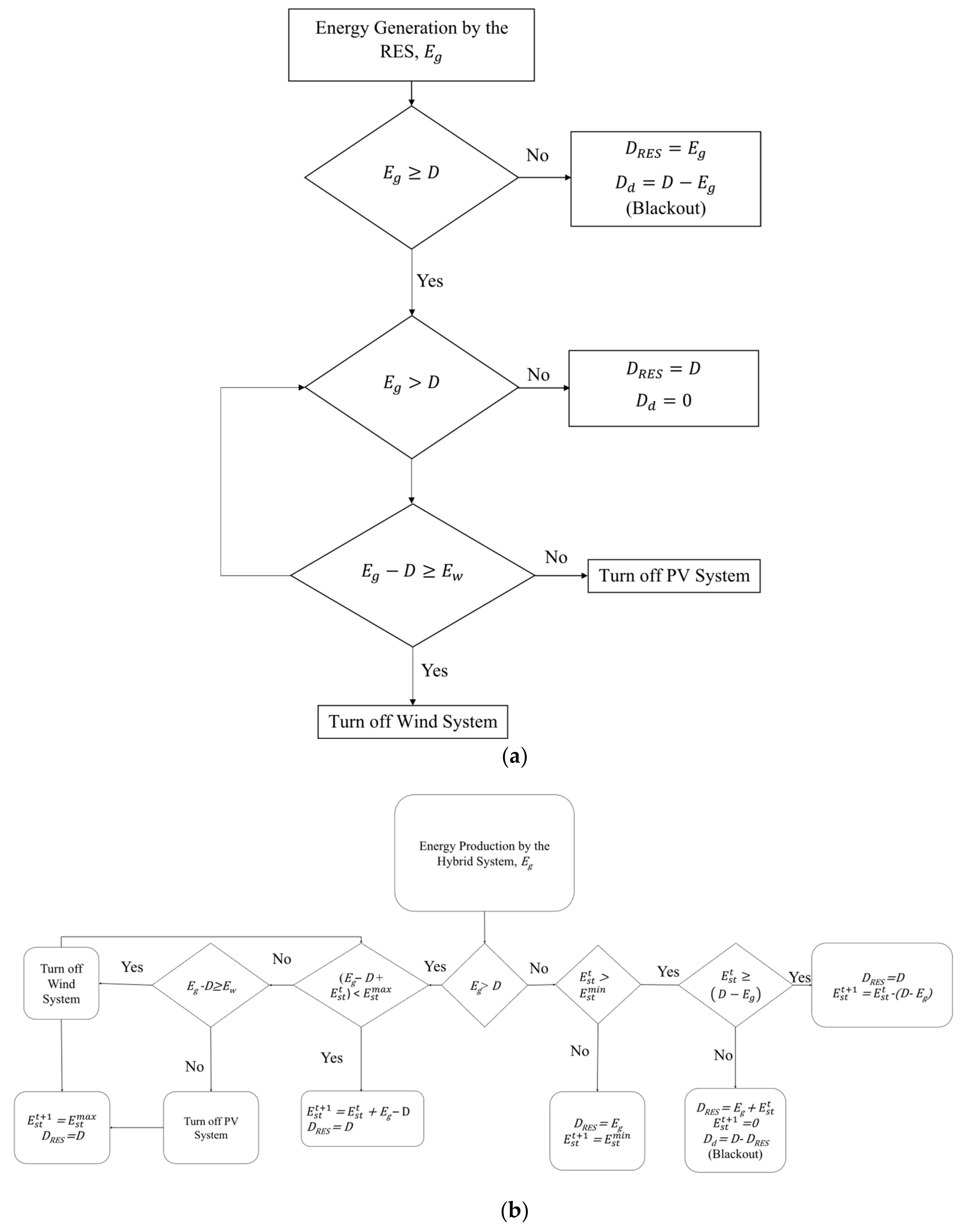
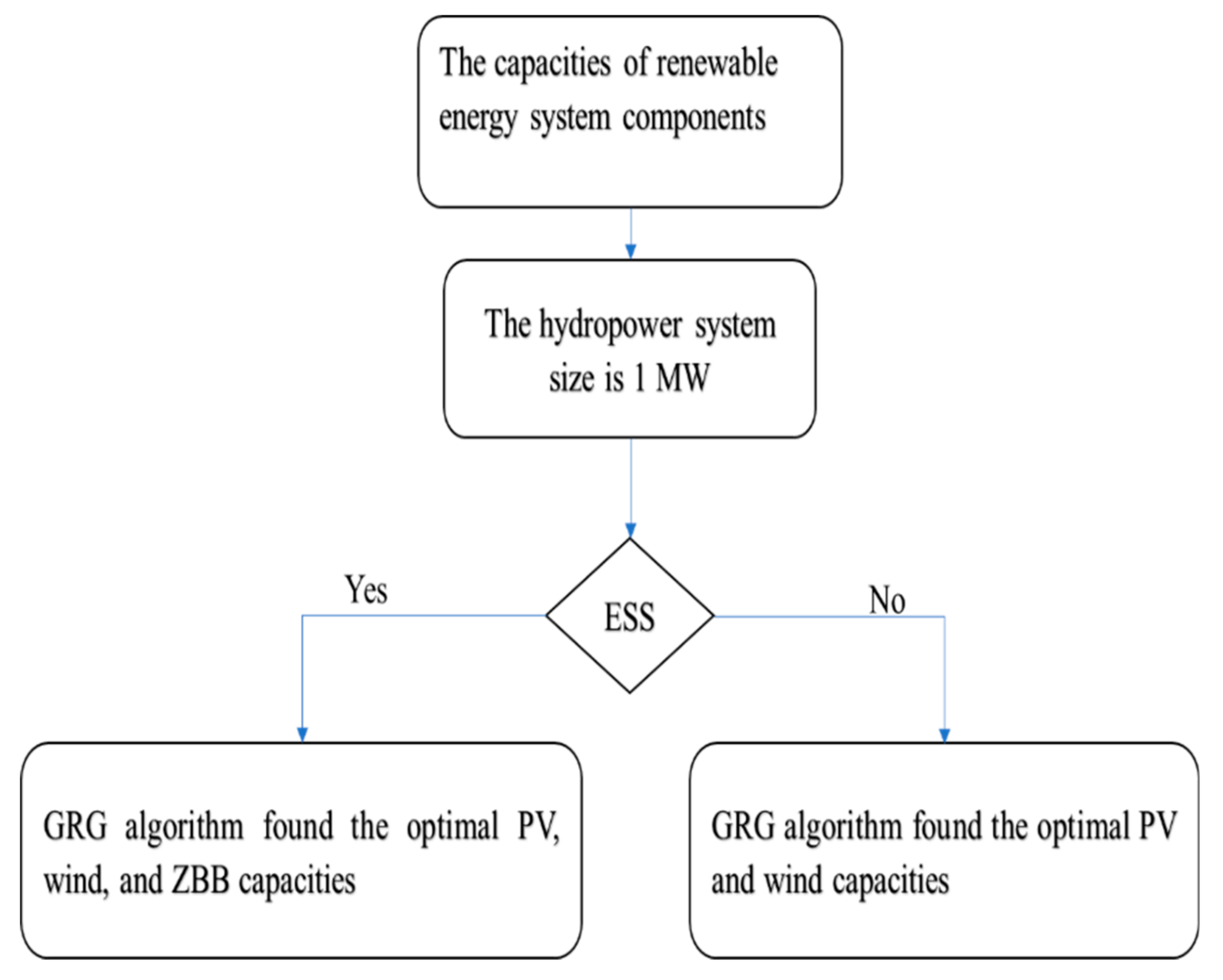
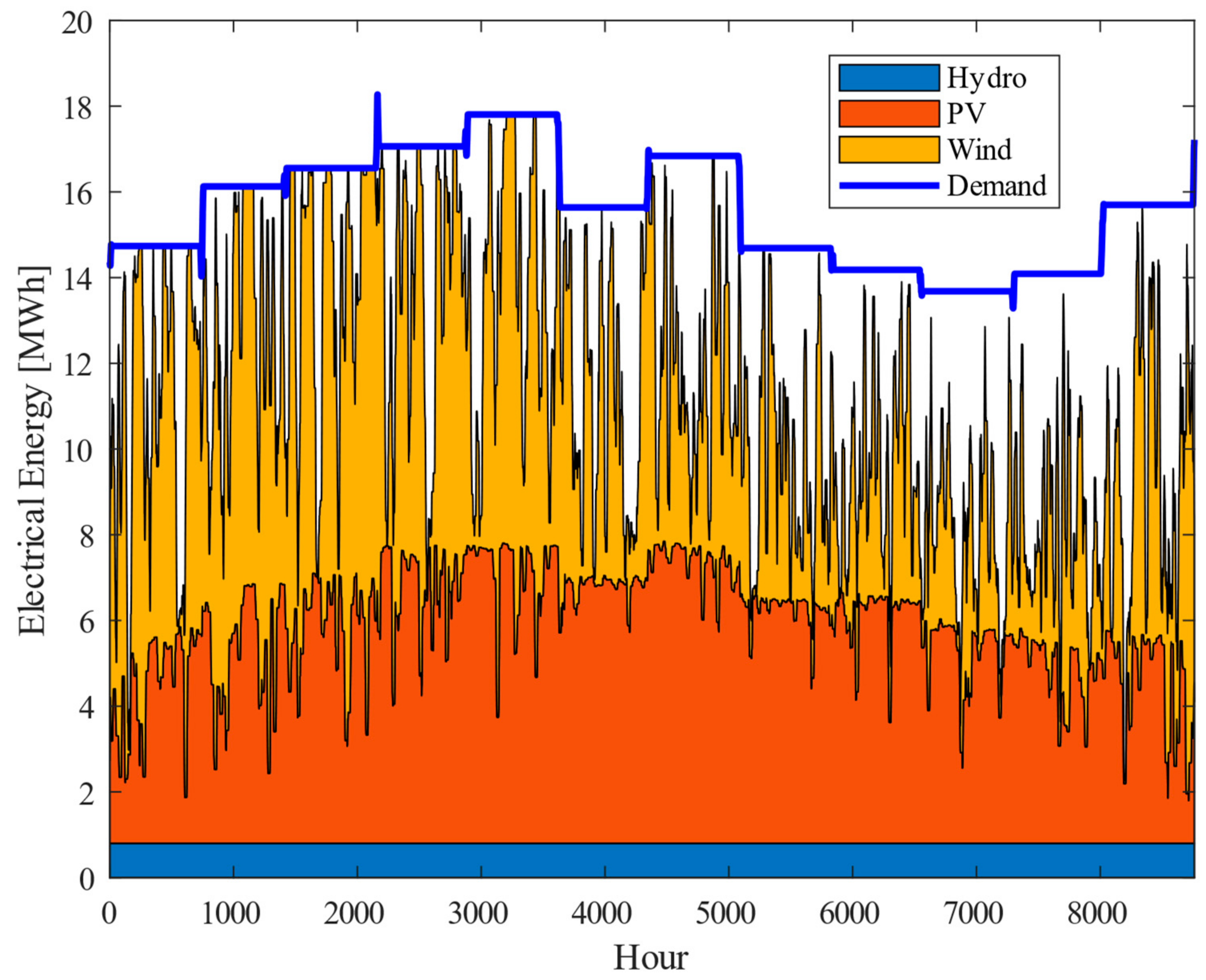
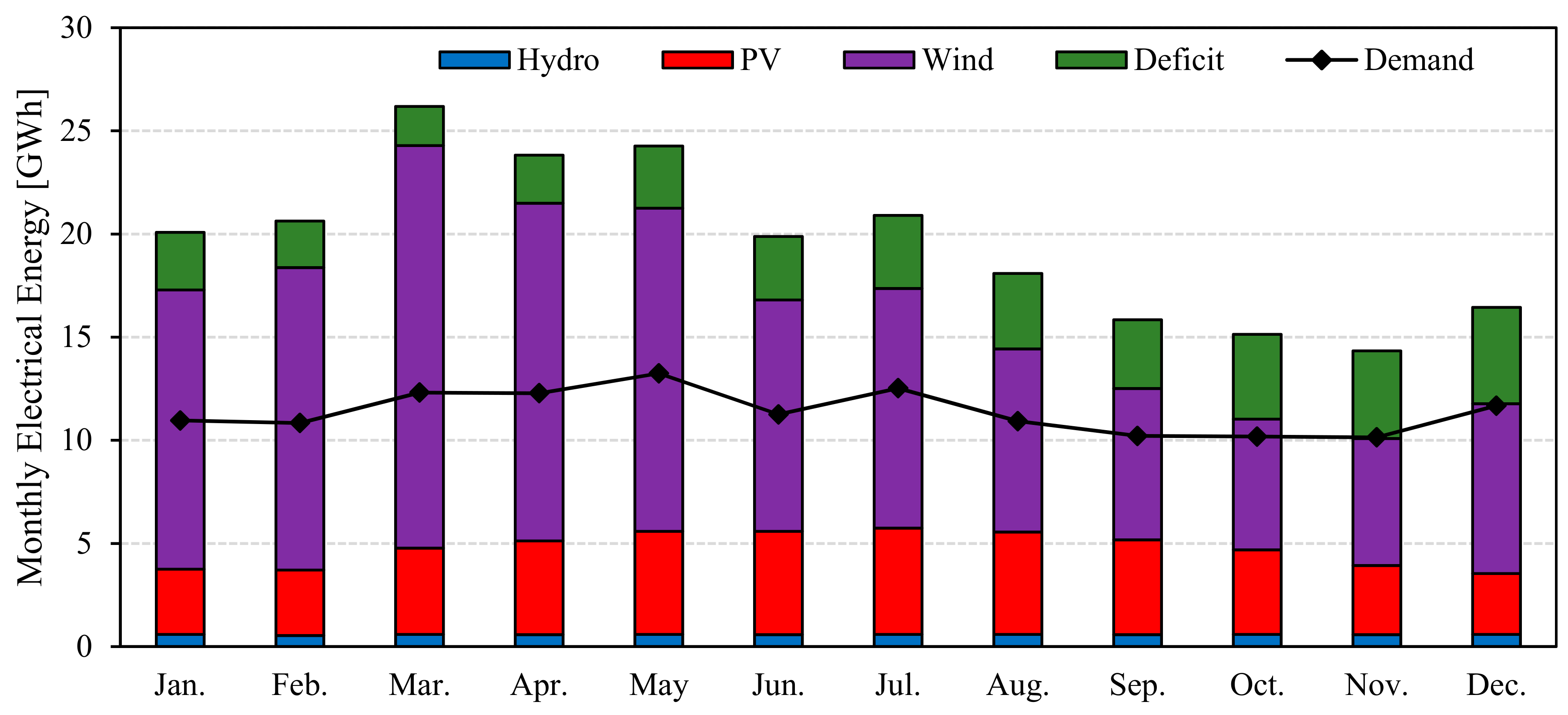
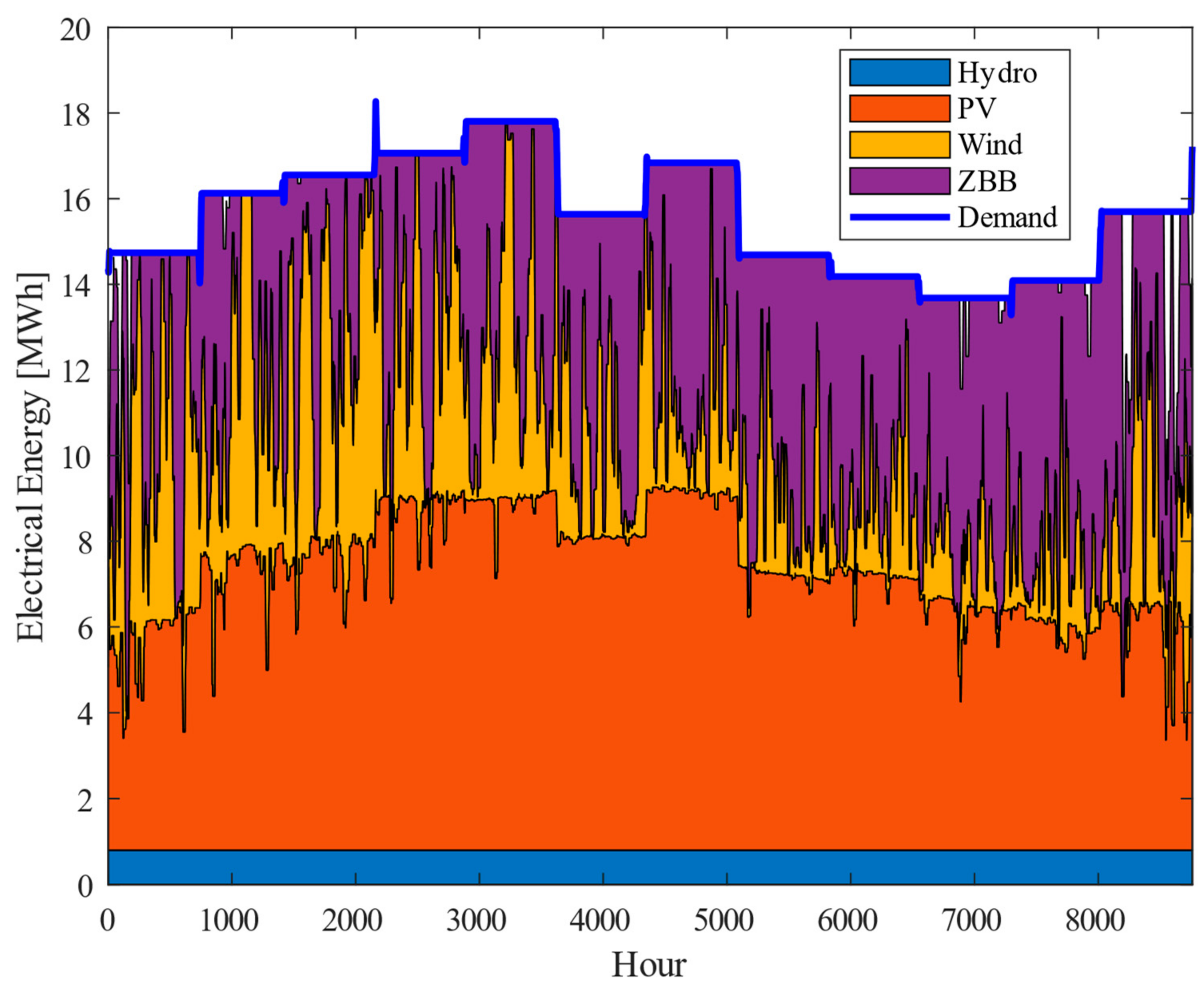
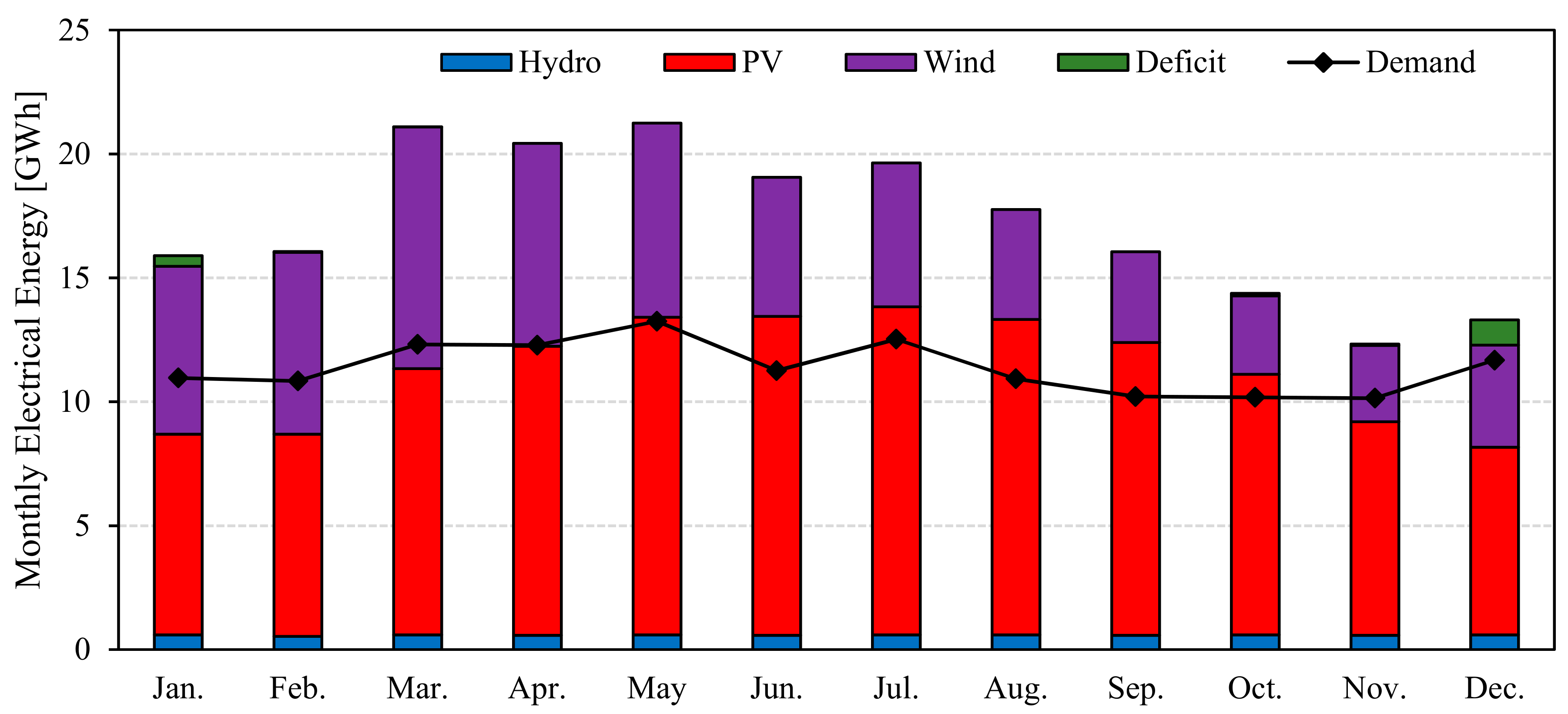
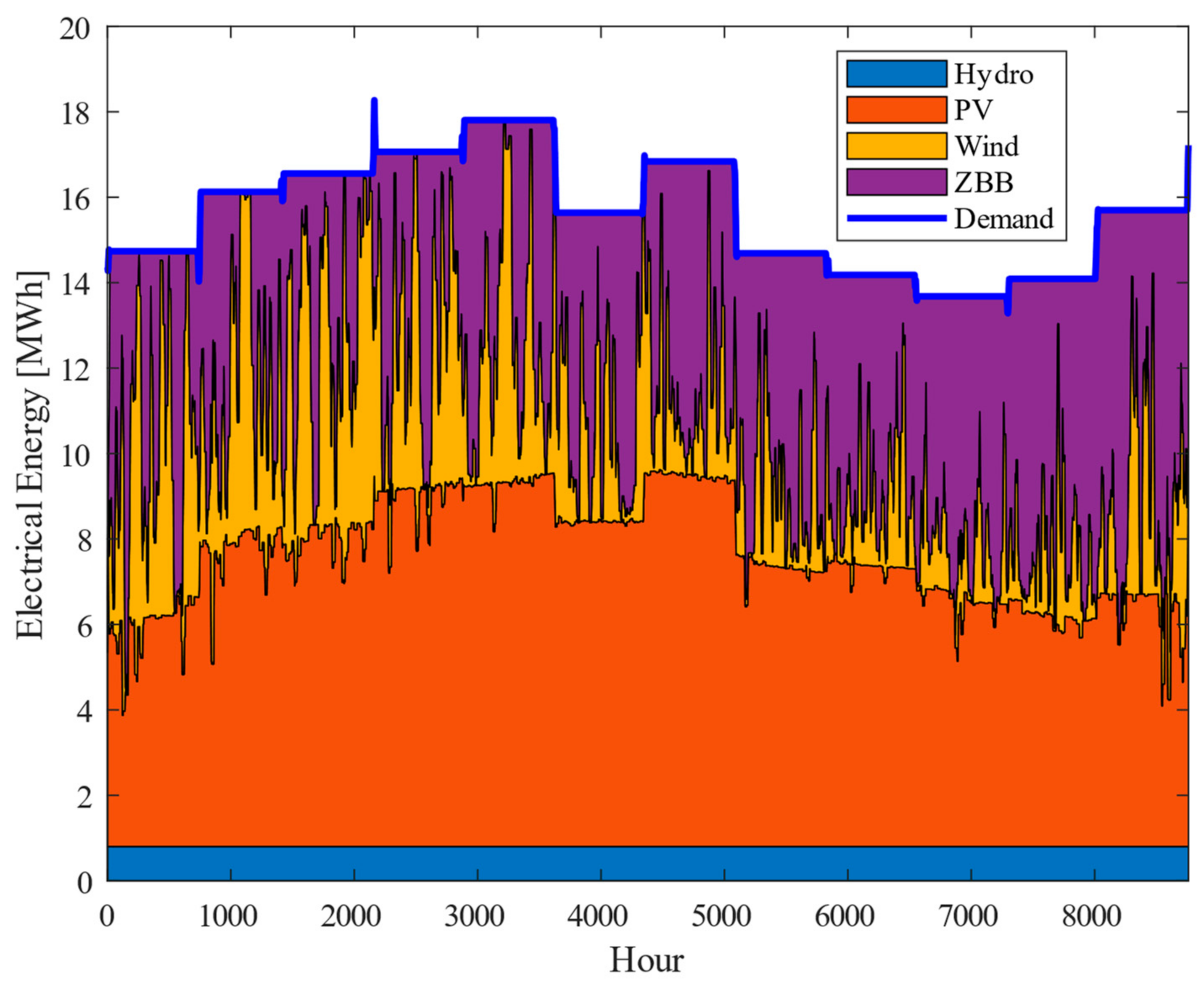
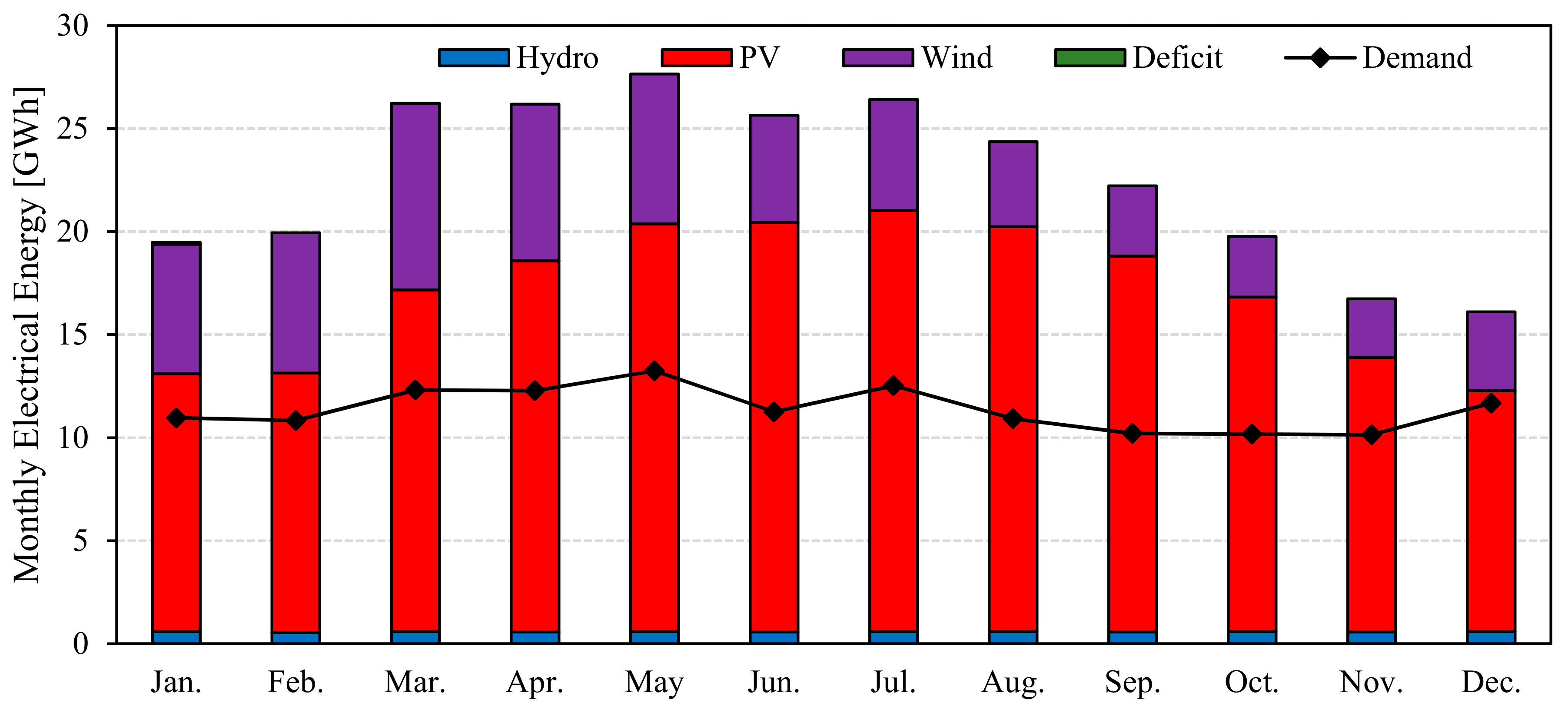
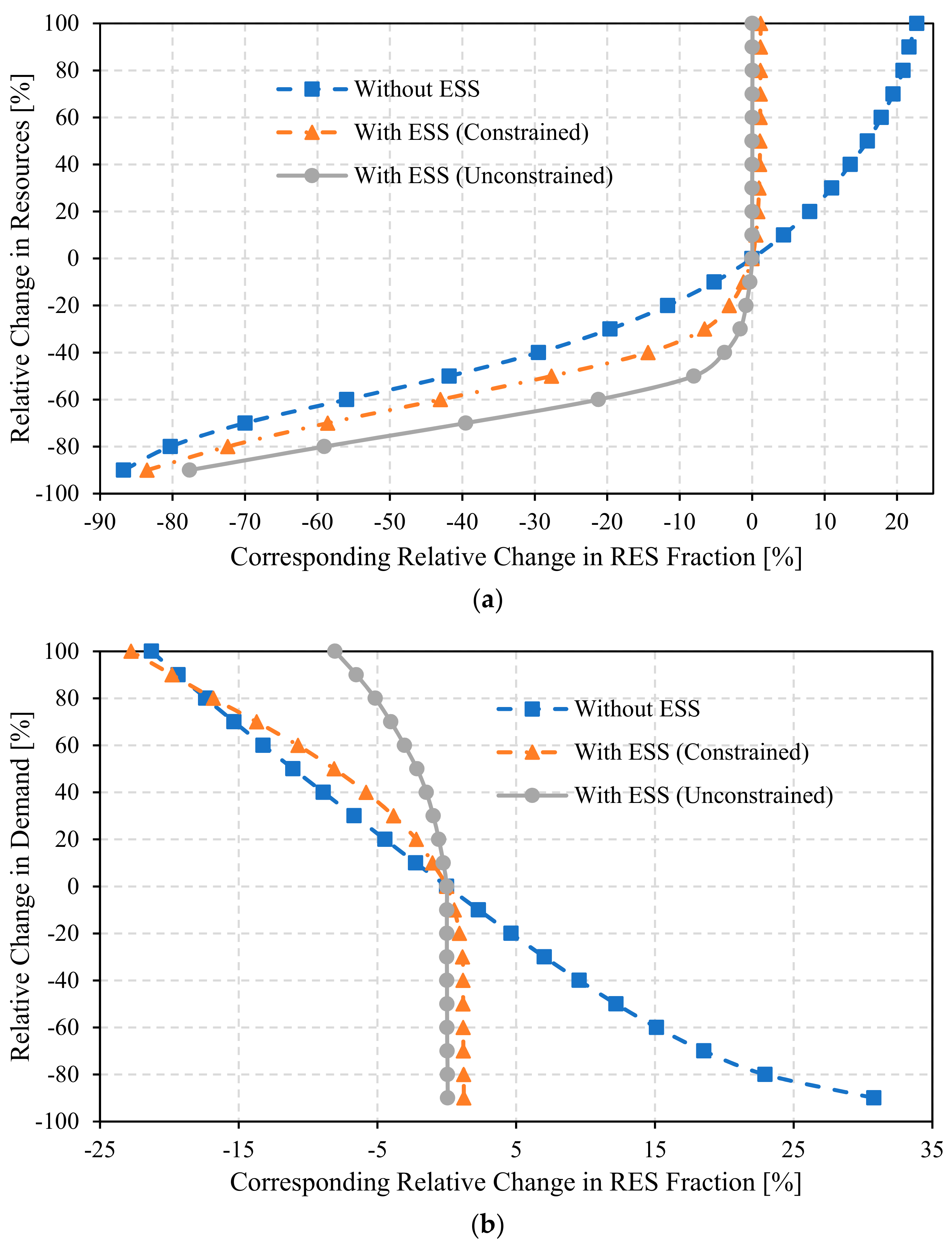
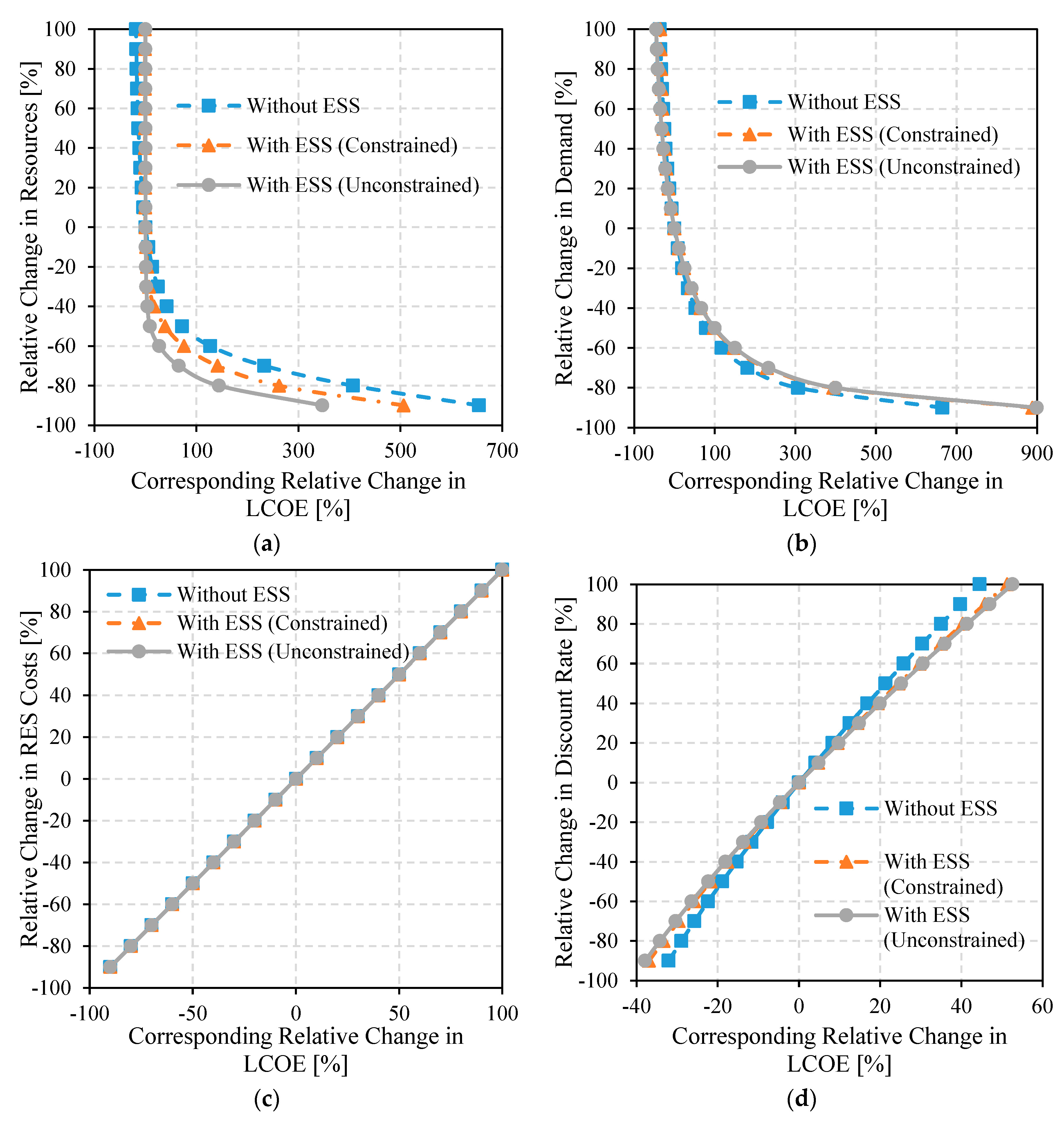
| Decision Variables | Objective Functions | Constraints | |
|---|---|---|---|
| Without ESS | With ZBB | ||
| PV and wind capacities | PV, wind and ZBB capacities | Maximizing FR | LCOE ≤ 0.12 |
| Parameter | Value | Reference |
|---|---|---|
| PV system capital cost ($/kW) | 1533 | [47] |
| Wind system capital cost ($/kW) | 1516 | [47] |
| Hydropower capital cost ($/kW) | 3000 | [41] |
| Zinc-Bromine capital cost ($/kW) | 195 | [48] |
| PV system maintenance cost ($/kW) | 24.68 | [49] |
| Wind system maintenance cost ($/kW) | 39.53 | [50] |
| Hydro power maintenance cost ($/kW) | 75 | [41] |
| System expected lifetime (Years) | 25 | [41,48,51] |
| Electricity purchase tariff ($/MWh) | 120 | [52] |
| Annual discount rate (%) | 5 | [37] |
| Parameter | Value |
|---|---|
| PV Capacity (MW) | 29.37 |
| Wind Capacity (MW) | 56 |
| Hydropower Capacity (MW) | 1 |
| Capacity Factor (%) | 26 |
| RES Fraction (%) | 71.5 |
| LCOE ($/kWh) | 0.12 |
| NPV (M$) | 167.53 |
| PBP (Years) | 6.235 |
| Parameter | Value | |
|---|---|---|
| Constrained | Unconstrained | |
| PV Capacity (MW) | 75.4 | 116.39 |
| Wind Capacity (MW) | 28 | 26 |
| Hydropower Capacity (MW) | 1 | 1 |
| ZBB (GWh) | 0.259 | 0.415 |
| Capacity Factor (%) | 22.48 | 21.55 |
| RES Fraction (%) | 98.79 | 99.93 |
| LCOE ($/kWh) | 0.12 | 0.165 |
| NPV (M$) | 119.55 | 140.45 |
| PBP (Years) | 9 | 9.62 |
© 2020 by the authors. Licensee MDPI, Basel, Switzerland. This article is an open access article distributed under the terms and conditions of the Creative Commons Attribution (CC BY) license (http://creativecommons.org/licenses/by/4.0/).
Share and Cite
Al-Ghussain, L.; Abujubbeh, M.; Darwish Ahmad, A.; Abubaker, A.M.; Taylan, O.; Fahrioglu, M.; Akafuah, N.K. 100% Renewable Energy Grid for Rural Electrification of Remote Areas: A Case Study in Jordan. Energies 2020, 13, 4908. https://doi.org/10.3390/en13184908
Al-Ghussain L, Abujubbeh M, Darwish Ahmad A, Abubaker AM, Taylan O, Fahrioglu M, Akafuah NK. 100% Renewable Energy Grid for Rural Electrification of Remote Areas: A Case Study in Jordan. Energies. 2020; 13(18):4908. https://doi.org/10.3390/en13184908
Chicago/Turabian StyleAl-Ghussain, Loiy, Mohammad Abujubbeh, Adnan Darwish Ahmad, Ahmad M. Abubaker, Onur Taylan, Murat Fahrioglu, and Nelson K. Akafuah. 2020. "100% Renewable Energy Grid for Rural Electrification of Remote Areas: A Case Study in Jordan" Energies 13, no. 18: 4908. https://doi.org/10.3390/en13184908
APA StyleAl-Ghussain, L., Abujubbeh, M., Darwish Ahmad, A., Abubaker, A. M., Taylan, O., Fahrioglu, M., & Akafuah, N. K. (2020). 100% Renewable Energy Grid for Rural Electrification of Remote Areas: A Case Study in Jordan. Energies, 13(18), 4908. https://doi.org/10.3390/en13184908





